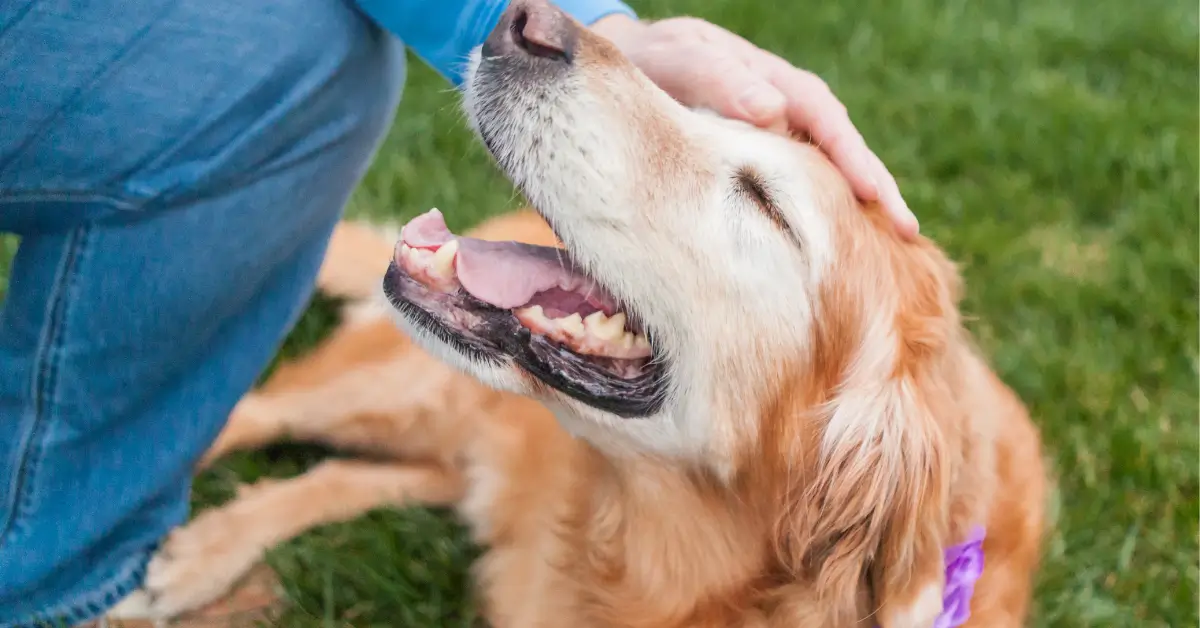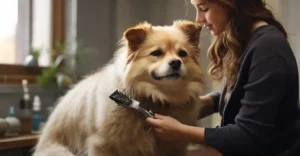Ever wondered why your dog seems to try to suffocate you with their cuddles? This article uncovers the heartfelt reasons behind your furry friend’s overly affectionate behavior. Dogs, our loyal companions, often express their love in the most physical ways. But sometimes, this can leave us feeling overwhelmed. We will delve into why your dog cuddles so close and how to understand and manage this behavior.
Our guide covers everything from the basics of canine affection to deeper issues like anxiety and the need for proper training. You’ll learn about creating a safe space for your dog, the importance of mental and physical stimulation, and when to seek professional help. This journey into the world of dog behavior is your pathway to a better understanding and a stronger bond with your beloved pet. Let’s explore together how to maintain a happy, healthy, and comfortable relationship with your dog.
Decoding Doggy Love: Why Your Dog Cuddles Close
Spotting Love: How Dogs Show Affection
Dogs have a special way of showing love to their owners. Cuddling or them being so close to you is a clear sign of their affection. They do this to feel safe and show they trust you as their owner and best friend. When your dog snuggles up, it’s like they are saying “I love you” in their own language.
This act of closeness is not just comforting for you, but also for them as they are able to show their playful and calm selves. It strengthens the bond between dogs and their owners. Understanding this behavior is crucial for ensuring a harmonious relationship with your furry friend.
Letting Dogs Be Dogs: The Need for Natural Behaviors
Dogs, as social animals, need to be close to others. They thrive on physical contact and companionship with their human families. Showing affection is part of their nature. It’s key to their emotional health. By allowing your dog to express this behavior, you meet their needs for bonding.
This helps create a happy and peaceful home. It’s important to let dogs be dogs. Encouraging their natural behavior in a balanced way is essential for their well-being.
Understanding and Nurturing Your Dog’s Bond with You
Dogs see their human families as their pack. They naturally seek to strengthen this bond. Physical closeness is part of how they do this. By understanding your dog’s behavior, you can build a stronger relationship.
This involves recognizing and responding to their actions in a positive way. Nurturing this bond is about more than just affection. It’s about building trust and affection with your canine companion. A strong bond ensures a harmonious relationship. This is key to fostering a healthy and loving connection with your dog.
Uncovering the Reasons Behind Suffocating or Smothering Behavior
Anxiety and Fear: When Separation Becomes a Problem
Dogs might try to suffocate their owners because of separation anxiety. This anxiety makes them overly clingy. They seek comfort and reassurance by staying close, especially when they feel alone.
This behavior is a way for them to feel secure. Dogs may resort to suffocating behaviors as they seek a sense of security from their owners. To help them, it’s essential to recognize these signs of anxiety.
Creating a calming environment can prevent these suffocation attempts. Providing them with familiar items when you’re away might also help. Comfort toys can divert their attention and reduce their stress.
The Impact of Inadequate Training and Boundaries on Canine Behavior
A common reason dogs may try to suffocate their owners is due to a lack of training and established boundaries. Owners should establish clear boundaries so their dogs better understand the limits of acceptable behavior.
If owners don’t, dogs may interpret their close contact as normal, not realizing it could be overwhelming for their human companions. This behavior can stem from not learning commands like “stay” or “off,” which help define personal space. In the absence of these boundaries, dogs might not recognize when their affectionate actions, like trying to cuddle or lie on top of their owners, become too much.
Understanding this aspect of dog behavior highlights the importance of training and setting boundaries from an early age. This lack of training can lead to situations where a dog’s natural inclination for closeness may seem like an attempt to suffocate, reflecting their uncertainty about the limits of interaction with their human family members.
Health and Sensation: When Dogs Seek Extra Stimulation
Sometimes, dogs may try to suffocate their owners as a way to seek more exciting activities. Providing them with mental stimulation is key. Activities and toys that challenge their minds can divert their attention from clingy behaviors. This includes puzzle toys and interactive games.
These tools not only entertain them but also keep them mentally engaged. It’s essential to balance physical affection with activities that fulfill their need for mental stimulation.
This approach prevents them from attempting to suffocate for attention and keeps them content and engaged.
Reading the Signs: Interpreting Canine Body Language
Understanding your dog’s body language is vital in managing their behavior. Dogs communicate a lot through their actions. Signs like growling or stiffening indicate discomfort. It’s important to respect these signals and adjust your interactions.
Learning about a dog’s body language helps in building a strong bond. It also creates a comfortable environment for both the dog and the owner.
Recognizing and responding to your dog’s body language can prevent misunderstandings and strengthen the bond between you and your canine companion.
Effective Ways to Manage Your Dog’s Over-Cuddling
Creating a Dog-Friendly Safe Space
To make your dog feel secure, create a special area for them. This space should have their dog bed, favorite blanket, and toys. It’s a place where they can relax and feel comfortable.
This setup helps your dog know they have a safe spot in the house. It’s important for dogs to have a retreat space, especially when they feel overwhelmed. This space also teaches them to enjoy time alone. It’s part of creating a safe and comfortable environment for your dog.
Encouraging them to use this space can help redirect their energy from clingy behaviors to resting and playing in their own area.
Keeping Your Dog Busy: The Importance of Stimulation
Interactive games and puzzle toys are great for keeping your dog busy. They provide both mental and physical stimulation. This kind of play helps use up your dog’s energy.
It also keeps their mind sharp. Busy dogs are less likely to show clingy behavior. Regular exercise is also crucial. It helps ensure your dog is happy and healthy.
Playtime, walks, and interactive play are all good ways to keep your dog engaged. This approach helps in addressing separation anxiety and reinforcing proper behaviors.
Teaching Space: How to Set Healthy Boundaries
Setting rules and boundaries is important for teaching dogs about personal space. Use treats or praise to reward your dog when they respect your space.
This method is part of positive reinforcement. Dogs learn best when treats are involved and it also encourages good behavior. Patience and consistency are needed to a successful training.
Over time, your dog will learn the importance of boundaries. This training helps in creating a harmonious living space for both humans and dogs. Remember, reinforcing positive behaviors is key in teaching your dog how to behave.
When to Call the Experts: Seeking Professional Training
Sometimes, professional help is needed to manage your dog’s behavior. If your dog’s clingy behavior persists, it might be time to seek a trainer or behaviorist.
They can provide expert advice and behavior modification techniques. These professionals can address specific issues your dog has and help create an environment for effective learning.
Their guidance can be invaluable in managing challenging behaviors. Professional training can also provide you insights about your dog’s behavior and this is for you to know what to improve and what to do next time. This helps in ensuring a safe and comfortable relationship between you and your dog.
Wrapping Up: Building a Stronger Bond with Your Dog
Wrapping Up: Building a Stronger Bond with Your Dog
In conclusion, understanding your dog’s cuddly behavior is key to a happy and harmonious life together. We’ve explored the reasons why your dog might seem to suffocate you with love, from seeking comfort and security to the importance of training and setting boundaries.
Each dog is unique, and their behavior tells a story of their emotions and need for attention. Remember, providing a safe space for your dog, engaging them in stimulating activities, and reinforcing positive behaviors are essential.
These steps help manage their clingy tendencies and ensure they feel loved and secure. If behavioral problems persist, don’t hesitate to seek advice from a professional trainer or behaviorist because they can provide tailored strategies to address your dog’s specific needs.
As you apply these insights and tips, you’ll find that you’re not just addressing a behavior but also deepening your bond with your furry companion.
Your understanding and response to their actions can make all the difference in nurturing a lasting, loving relationship. Here’s to a more comfortable, joyful, and connected life with your beloved dog!
FAQ: Understanding and Managing Your Dog’s Affectionate Behavior
What are some interactive toys that can help alleviate my dog’s need for constant attention?
Interactive toys are great for providing mental stimulation and reducing your dog’s need for constant attention. Puzzle toys that dispense treats, balls that make intriguing noises, and toys that mimic prey movements can keep your dog engaged. These toys help in channeling their energy positively and prevent clingy behaviors.
How can I understand the various reasons behind my dog’s clingy behavior?
Clingy behavior in dogs can stem from several reasons like separation anxiety, lack of training, or even boredom. Observing when and how your dog exhibits these behaviors can offer valuable insights.
For instance, if they become clingy when you’re about to leave, it might be anxiety-driven. Understanding these triggers is crucial in addressing the root cause effectively.
What positive reinforcement techniques can dog owners use to encourage appropriate behavior?
Positive reinforcement involves rewarding good behavior to encourage repetition. Treats, praise, and extra playtime are effective rewards.
Consistency in rewarding appropriate behavior, like staying calm or respecting boundaries, reinforces these actions. It’s important to be patient and consistent with these techniques for the best results.
In what ways can a behaviorist provide professional advice to help with my dog’s suffocation attempts?
A behaviorist can offer tailored strategies based on your dog’s specific behaviors and needs. They can help you understand the underlying causes of your dog’s actions and develop a personalized training plan.
This might involve behavior modification techniques and methods to strengthen your bond with your dog, ultimately helping to prevent suffocation attempts.
How can I assert dominance in a way that makes my dog feel comfortable and secure?
Asserting dominance doesn’t mean being harsh. It’s about establishing yourself as the pack leader in a calm and assertive manner. Consistent rules, structured routines, and clear boundaries help convey your leadership.
This approach makes your dog feel secure and understand their role in the family, fostering a comfortable environment.



